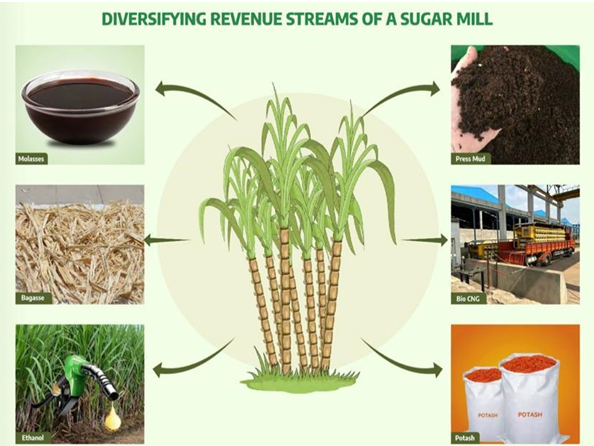Fuelling the rural economy and empowering farmers through a resurgent sugar sector
Fuelling the rural economy and empowering farmers through a ... Rising Kashmir


Government of India Announces Fair and Remunerative Price for Sugarcane

The Government of India has recently announced the Fair and Remunerative Price (FRP) of Rs 315/quintal for sugarcane for Sugar Season 2023-24 with more than 100% margin over Paid out cost + imputed value of family labour (A2+FL cost). This decision aims to benefit about 5 crore sugarcane farmers and their dependents, assuring high returns for farmers. The new FRP aligns with the Sustainable Development Goals (SDGs) by addressing the aspirations of the farmers while ensuring competitiveness of the Indian sugar industry. The FRP serves as the benchmark price below which no sugar factory can purchase sugarcane, similar to the Minimum Support Price (MSP) concept.
The Turnaround of the Sugar Sector
The sugar industry in India has had a chequered history, but it has emerged as a robust sector in recent years. In the eight years leading up to 2020-21, the Government of India provided financial assistance of more than Rs 18,000 crores to rescue the sugar sector from financial crises, ensuring prompt payments to farmers. Targeted interventions from the Central Government, combined with the acumen of the sugar industry and favorable global factors, have led to a turnaround of the sugar sector. The health of the sector can be measured by the fact that since 2021-22, no budgetary support has been given to sugar mills, except under the interest subvention scheme for ethanol projects. The sector has witnessed increased capital expenditure, modernization, and diversification, with over Rs 30,000 crore of additional investment in the last six years and the creation of more than 50,000 direct and indirect employment opportunities for rural youth. The stock prices of listed sugar companies have also shown significant growth, indicating a positive outlook for the sector.
Factors Contributing to the Turnaround
The revival of the sugar sector can be attributed to three broad factors:
- The National Biofuel Policy 2018: The National Biofuel Policy has played a crucial role in reviving the sugar sector. It promotes blending of ethanol with petrol and has simplified the procedures for establishing ethanol plants. Remunerative prices for ethanol produced from molasses have been offered, and an interest subvention scheme for ethanol projects has been introduced to incentivize enhanced ethanol production capacity. The Ethanol Blending with Petrol (EBP) Programme has doubled the ethanol blending percentage, surpassing the target of 10% and is on track to achieve the target of 20% blending by 2025. This has resulted in additional revenue of more than Rs 51,000 crores for sugar-based distilleries in the last four years.
- Export of Sugar: India has become the second-largest exporter of sugar in the world, with exports reaching 110 lakh tons in the sugar season 2021-22. This has enabled sugar mills to dispose of their additional inventory and generate revenue from higher global prices.
- Diversification of Product Basket: The sugar sector has diversified its product basket, contributing to a circular economy with minimal environmental impact. The industry has utilized co-gen power, potash-based fertilizers, and press mud to generate Compressed Bio Gas (CBG). Sugar mills have effectively used bagasse to generate power for their own requirements and surplus electricity for the grid. Water usage has also decreased due to increased adoption of drip irrigation and efficient water management in integrated sugar complexes. The sector is well-positioned to earn and monetize carbon credits, contributing to India’s targets under COP 26 agreements towards Net Zero Emissions.
Benefits for Stakeholders
The increased profitability of sugar mills has benefitted both farmers and consumers. Improved cash flows have led to faster clearance of cane dues, with 90.8% of the dues paid to farmers as of July 1, 2023. Domestic sugar prices have remained stable, resulting in nominal inflation of less than 3%. In contrast, retail prices in neighboring countries are significantly higher. The sugar sector has become more robust and self-reliant, generating additional revenue streams and transitioning to a green energy hub.
Overall, the turnaround of the sugar sector can be attributed to the concerted efforts of stakeholders and the conducive policy ecosystem.
(The Author is Secretary, D/o Food & Public Distribution)
SDGs, Targets, and Indicators Analysis
1. Which SDGs are addressed or connected to the issues highlighted in the article?
- SDG 1: No Poverty
- SDG 2: Zero Hunger
- SDG 7: Affordable and Clean Energy
- SDG 8: Decent Work and Economic Growth
- SDG 12: Responsible Consumption and Production
- SDG 13: Climate Action
The issues highlighted in the article are connected to several SDGs. The focus on fair and remunerative prices for sugarcane aims to address poverty (SDG 1) and hunger (SDG 2) by ensuring high returns for farmers. The promotion of blending ethanol with petrol contributes to affordable and clean energy (SDG 7) and responsible consumption and production (SDG 12). The generation of green power through cogeneration infrastructure and the use of press mud to generate Compressed Bio Gas (CBG) align with climate action (SDG 13). The overall improvement in the sugar sector’s profitability and stability in domestic sugar prices contribute to decent work and economic growth (SDG 8).
2. What specific targets under those SDGs can be identified based on the article’s content?
- SDG 1.2: By 2030, reduce at least by half the proportion of men, women, and children of all ages living in poverty in all its dimensions according to national definitions.
- SDG 2.3: By 2030, double the agricultural productivity and incomes of small-scale food producers, in particular women, indigenous peoples, family farmers, pastoralists, and fishers, including through secure and equal access to land, other productive resources and inputs, knowledge, financial services, markets, and opportunities for value addition and non-farm employment.
- SDG 7.2: By 2030, increase substantially the share of renewable energy in the global energy mix.
- SDG 8.3: Promote development-oriented policies that support productive activities, decent job creation, entrepreneurship, creativity, and innovation, and encourage the formalization and growth of micro-, small- and medium-sized enterprises, including through access to financial services.
- SDG 12.2: By 2030, achieve the sustainable management and efficient use of natural resources.
- SDG 13.2: Integrate climate change measures into national policies, strategies, and planning.
The article’s content aligns with specific targets under the identified SDGs. The focus on fair prices for sugarcane aims to reduce poverty (SDG 1.2) by ensuring higher incomes for farmers. The promotion of ethanol blending contributes to increasing the share of renewable energy (SDG 7.2) and achieving sustainable management and efficient use of natural resources (SDG 12.2). The improvement in the sugar sector’s profitability and generation of employment opportunities align with promoting decent job creation (SDG 8.3). The sector’s initiatives for green power generation and reduction of water usage contribute to integrating climate change measures (SDG 13.2).
3. Are there any indicators mentioned or implied in the article that can be used to measure progress towards the identified targets?
- Percentage of farmers receiving fair and remunerative prices for sugarcane
- Increase in agricultural productivity and incomes of small-scale food producers
- Share of renewable energy in the energy mix
- Number of employment opportunities generated in the sugar sector
- Reduction in water usage by sugar mills
- Amount of ethanol blended with petrol
The article mentions or implies indicators that can be used to measure progress towards the identified targets. The percentage of farmers receiving fair and remunerative prices for sugarcane can be used to assess progress towards reducing poverty (SDG 1.2) and increasing agricultural incomes (SDG 2.3). The share of renewable energy in the energy mix and the amount of ethanol blended with petrol can measure progress towards increasing renewable energy (SDG 7.2) and achieving sustainable management of resources (SDG 12.2). The number of employment opportunities generated in the sugar sector can indicate progress towards decent job creation (SDG 8.3). The reduction in water usage by sugar mills can be an indicator of integrating climate change measures (SDG 13.2).
SDGs, Targets, and Indicators Table
| SDGs | Targets | Indicators |
|---|---|---|
| SDG 1: No Poverty | Target 1.2: By 2030, reduce at least by half the proportion of men, women, and children of all ages living in poverty in all its dimensions according to national definitions. | Percentage of farmers receiving fair and remunerative prices for sugarcane |
| SDG 2: Zero Hunger | Target 2.3: By 2030, double the agricultural productivity and incomes of small-scale food producers, in particular women, indigenous peoples, family farmers, pastoralists, and fishers, including through secure and equal access to land, other productive resources and inputs, knowledge, financial services, markets, and opportunities for value addition and non-farm employment. | Increase in agricultural productivity and incomes of small-scale food producers |
| SDG 7: Affordable and Clean Energy | Target 7.2: By 2030, increase substantially the share of renewable energy in the global energy mix. | Share of renewable energy in the energy mix |
| SDG 8: Decent Work and Economic Growth | Target 8.3: Promote development-oriented policies that support productive activities, decent job creation, entrepreneurship, creativity, and innovation, and encourage the formalization and growth of micro-, small- and medium-sized enterprises, including through access to financial services. | Number of employment opportunities generated in the sugar sector |
| SDG 12: Responsible Consumption and Production | Target 12.2: By 2030, achieve the sustainable management and efficient use of natural resources. | Reduction
Behold! This splendid article springs forth from the wellspring of knowledge, shaped by a wondrous proprietary AI technology that delved into a vast ocean of data, illuminating the path towards the Sustainable Development Goals. Remember that all rights are reserved by SDG Investors LLC, empowering us to champion progress together. Source: risingkashmir.com
Join us, as fellow seekers of change, on a transformative journey at https://sdgtalks.ai/welcome, where you can become a member and actively contribute to shaping a brighter future.
|








